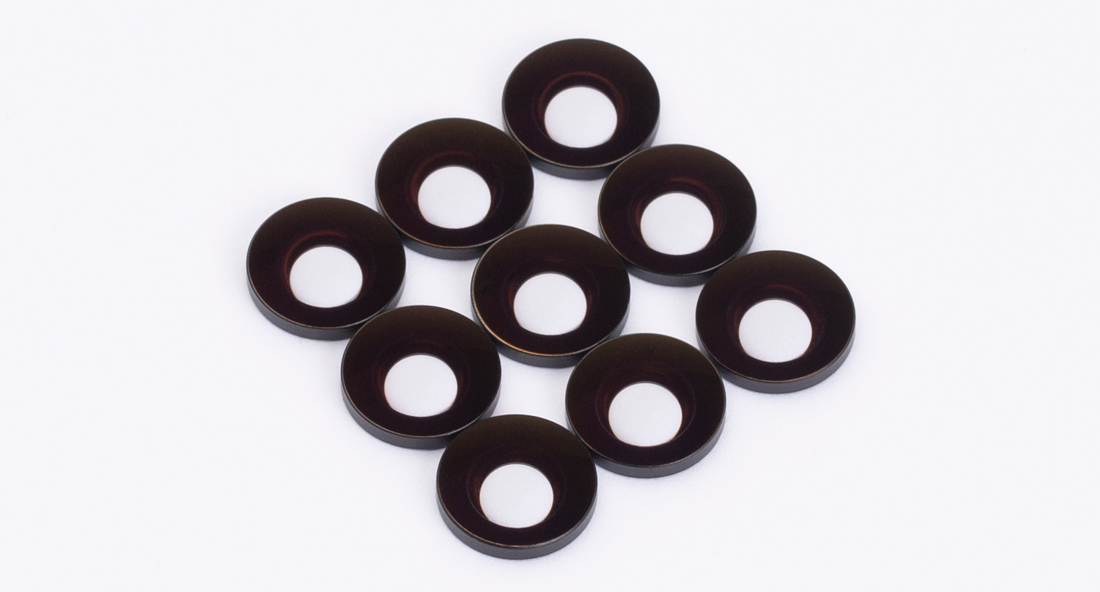1. Natural material - crystal lens
The main component of this material is silica, which is usually divided into two types: colorless and brown. The material is not easy to wear and has a small thermal expansion coefficient. Due to its unique transparency to ultraviolet rays, it is easy to cause visual fatigue when wearing it. In addition, due to the uneven density of the material such as crystal, the lens often contains impurities, which is prone to birefringence during use.
2. Glass lens
It is the main material for the production of lenses, which can be divided into the following five types:
Toric
This kind of lens is also called white support film, white film and optical white film. Its basic component is sodium titanium silicate, which is colorless and transparent, with high clarity and can absorb ultraviolet rays of optical lenses below 330A. Adding Ceo2 and Tio2 to the white support film can prevent ultraviolet rays below 346A, so it is also called UV white film. Its visible light transmittance is 91-92%, and the refractive index is 1.523.
Crox Piece
Commonly known as Kexian film, the light transmittance is 87%. This lens has a two-color effect, which is light blue under sunlight (so it is also called blue film), and light red under incandescent light (because it contains metallic element neodymium), which can absorb ultraviolet rays below 340A, part of infrared rays and yellow at 580A visible light.
Commonly known as Kesai film, adding Ceo2 and Mno2 to the white support lens material can improve the ultraviolet absorption capacity. This kind of optical lens lens is light red under sunlight and incandescent light, so it is also called red lens. It can absorb ultraviolet rays below 350A, and the light transmittance is above 88%.
Ultra-thin
This kind of lens has Tio2 and Pbo added to the raw material, so that the refractive index is increased to 1.70. Its surface reflectivity is high, and it is about 1/3 thinner than the ordinary one-diopter white or red film. It is suitable for wearing with high myopia and has a beautiful appearance. In addition, due to the low Abbe coefficient and large chromatic aberration, ultra-thin slices are prone to reduce peripheral vision, and colors will appear when the lines are curved.
1.60 glass lens
The refractive index of this lens is 1.60, which is thinner than ordinary glass lens (1.523), and the specific gravity of the ultra-thin lens (focusing lens 1.70) is smaller, so it is very light, very suitable for moderate wearers, some manufacturers call it Ultra-light and ultra-thin lenses.
Fluorite is formed by crystallizing calcium fluoride (CaF2). Its obvious feature is that the refractive index and dispersion are extremely low, and the transmittance to infrared rays and ultraviolet rays is good. But there is another point worth paying attention to: it also has vivid and delicate description performance that ordinary optical glass cannot achieve. Because the focus of light passing through a general lens will diverge, and the sharpness of the captured image will decrease, we call it chromatic aberration. Fluorite lenses have very little light dispersion and almost no chromatic aberration, so they are the most suitable lenses for photography. However, in nature, there is almost no fluorite that can be used in a single-lens reflex camera lens as large as an aspherical lens, so it can be said that it has been a long-standing desire to manufacture artificially generated fluorite lenses.
Fluorite lens material
Fluorite lenses are made of Fluorite, also known as fluorite, which is a mineral whose main component is calcium fluoride (CaF2), which contains many impurities. Ca is often replaced by rare earth elements such as Y and Ce. In addition, it also contains a small amount of Fe2O3, SiO2 and a small amount of Cl, O3, He and so on. Fluorite in nature often shows bright colors, and its hardness is lower than that of pocket knives. Fluorite is an excellent optical material, and the lenses made of fluorite have excellent optical qualities, especially in terms of anti-dispersion properties, far exceeding all other optical materials.
Optical lenses


We are looking forward to establishing long-term cooperative relations with customers around the world on the basis of trust and mutual benefit. Please feel free to contact us for further information. We sincerely welcome you to our factory.
Copyright © Jiangxi High-Resolution Optoelectronic Co., Ltd. All Rights Reserved | Sitemap